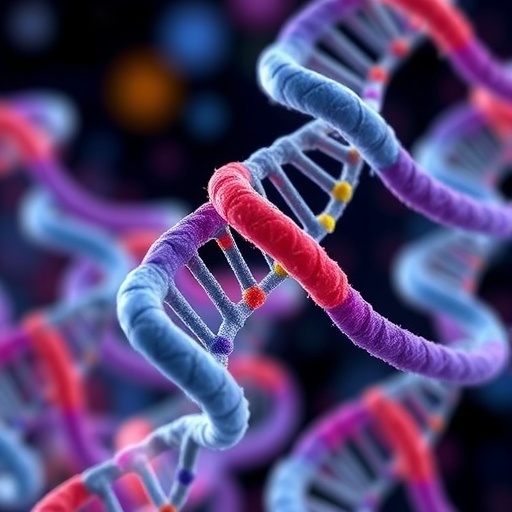In a groundbreaking study that enhances the understanding of protein-DNA interactions, Zhang et al. have proposed a novel prediction method that leverages the power of advanced computational techniques to identify binding sites. The research showcases a sophisticated approach that combines protein language models with a unique architectural design of a pyramidal neural network, integrating the SE (Squeeze-and-Excitation) connection mechanism. This innovative framework is set to revolutionize the way we predict and analyze protein-DNA binding sites, which are critical for regulating numerous biological processes.
The interaction between proteins and DNA is fundamental to cellular function. Proteins binding to specific DNA sequences can significantly influence gene expression, replication, and repair mechanisms. Understanding these interactions at a molecular level is essential, given their implications in diverse areas such as cancer biology, genetic disorders, and gene therapy. With the complexity of these interactions, traditional experimental methods can be time-consuming and costly, which underscores the need for reliable in silico prediction models.
The team led by Zhang harnessed the advancements made in protein language models—an area that has seen significant progress due to developments in natural language processing (NLP). By treating protein sequences similarly to how NLP handles text data, they were able to extract intricate features embedded within the sequences themselves. This allows for a deeper understanding of how proteins recognize and bind to specific DNA motifs, thus enhancing the predictive accuracy for these critical interactions.
Importantly, the study introduces the SE-connection pyramidal network architecture, which sets it apart from previous models. This architecture is designed to capture multi-scale features through a pyramidal structure while also utilizing the capabilities of squeeze-and-excitation networks to recalibrate feature responses adaptively. By enhancing the model’s sensitivity to salient features of protein-DNA interactions, this architecture improves the performance metrics crucial for binding site prediction.
The ensemble learning aspect of the proposed method further amplifies its predictive capabilities. Ensemble learning techniques involve combining predictions from multiple models to reduce variance and improve robustness. This means that by aggregating outputs from various sub-models, Zhang and his colleagues have crafted a prediction tool that not only increases accuracy but also provides more reliable confidence scores for each prediction made regarding protein-DNA interactions.
Experimental results revealed that the proposed model outperformed existing state-of-the-art prediction tools. The researchers benchmarked their method against established datasets, which included a comprehensive array of protein-DNA interactions, demonstrating a remarkable increase in sensitivity and specificity rates. The implications of these findings are vast, potentially leading to more targeted therapeutic approaches in the future as well as improved understanding of the fundamental biological processes.
In addition to its scientific contributions, this study highlights the increasing importance of computational approaches in genomic research. As the volume of biological data continues to burgeon, simplified yet powerful predictive models will be essential in extracting valuable insights. The methods employed by Zhang et al. underscore the transformative potential of integrating artificial intelligence and machine learning within biological frameworks.
Moreover, this research paves the way for further denser investigations into protein-DNA binding dynamics. As researchers begin to utilize this model, they could extend its application to other complex biological systems, such as protein-protein interactions and RNA-protein binding studies. In an age where biology and technology converge, such predictive methods hold the promise of uncovering novel biological interactions that could lead to actionable scientific advancements.
The clinical implications of refined protein-DNA interaction predictions could be monumental. By enabling researchers to predict binding sites with higher accuracy, the proposed model could assist in identifying new drug targets or elucidating mechanisms behind genetic diseases. This fusion of computational prowess and biological understanding can catalyze the development of more precise gene-editing techniques as well.
Additionally, the detailed nature of their findings offers a valuable resource for future studies in genetic engineering and therapeutic interventions. As the scientific community seeks to classify and understand the myriad of protein subjects and their functions, this model represents a significant tool that may aid researchers in crafting experimental designs around gene regulation and expression.
Beyond the immediate applications to health and disease research, this study showcases the broader relevance of advanced machine learning models across diverse biological disciplines. The clear delineation between research areas such as genomics, proteomics, and systems biology is increasingly blurred, emphasizing the necessity for integrative models that capture the complexity of life at a molecular level.
In conclusion, this study stands as a testament to the potential inherent in merging computational models with biological inquiry. The innovative design and robust approach proposed by Zhang et al. not only advance the field of protein-DNA interaction research but also set a precedent for future endeavors that aim to bridge technology with biological science. As we continue to unravel the complexities of genetic and protein interactions, this model may very well be a cornerstone of predictive biology in the years to come.
Subject of Research: Protein-DNA binding site prediction
Article Title: A novel prediction method for protein-DNA binding sites based on protein language model fusion features with SE-connection pyramidal network and ensemble learning
Article References:
Zhang, C., Jiang, J., Zhao, H. et al. A novel prediction method for protein-DNA binding sites based on protein language model fusion features with SE-connection pyramidal network and ensemble learning.
BMC Genomics 26, 979 (2025). https://doi.org/10.1186/s12864-025-12196-3
Image Credits: AI Generated
DOI:
Keywords: Protein-DNA interactions, predictive modeling, machine learning, ensemble learning, pyramidal network




